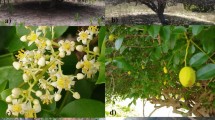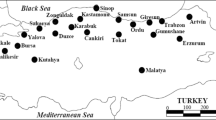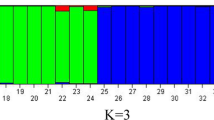Abstract
Saccharina (Laminaria) is an important economic seaweed. Simple sequence repeat (SSR) markers were developed for S. japonica from an SSR-enriched genomic library using a modified magnetic-bead enrichment protocol. Sequence analysis of 2,853 randomly picked recombinant colonies indicated that 1,092 of the colonies contained microsatellites. After filtration, the remaining 593 unique sequences were examined for their suitability and 266 primer pairs were ultimately designed. Among them, 179 could be used for genetic study by practicability tests. Then, 23 pairs of core primers with good representativeness were selected to analyze 13 Saccharina (Laminaria) gametophyte lines, which are widely used in breeding and economic cultivation in China. A total of 72 alleles were detected with an average of 3.13 alleles per locus. The Nei’s (1973) gene diversity (H) of these markers ranged from 0.1420 to 0.7222. Cluster analysis was generated from genetic distance by the Unweighted Pair-Group Method with Arithmetic Mean (UPGMA) which resolved the 13 lines into two main groups in accord with their geographic distribution. These results indicated that the SSR markers developed in this study were informative and would be useful for genetic analysis and germplasm management in Saccharina (Laminaria).


Similar content being viewed by others
References
Bassam BJ, Caetano-Anolles G, Gresshoff PM (1991) Fast and sensitive silver staining of DNA in polyacrylamide gels. Anal Biochem 196:80–83
Bi YH, Hu YJ, Zhou ZG (2011) Genetic variation of Laminaria japonica (Phaeophyta) populations in China as revealed by RAPD markers. Acta Oceanol Sin 30:103–112
Billot C, Boury S, Benet H, Kloareg B (1999a) Development of RAPD markers for parentage analysis in Laminaria digitata. Bot Mar 42:307–314
Billot C, Rousvoal S, Estoup A, Epplen JT, Saumitou-Laprade P, Valero M, Kloareg B (1999b) Isolation and characterization of microsatellite markers in nuclear genome of the brown alga Laminaria digitata (Phaeophyceae). Mol Ecol 7:1778–1780
Bronw J, Hardwick LJ, Wright AF (1995) A simple method for rapid isolation of microsatellites from yeast artificial chromosomes. Mol Cell Probes 9:53–57
Enrique AM, Leyla C, Cecilia F, Rodrigo UV, Claire B (2005) Microsatellites of Laminaria digitata tested in Lessonia nigrescens: Evaluation and improvement of cross amplification between kelps of two different families. J Appl Phycol 17(3):245–253
Fang TC, Wu CY, Jiang BY, Li JJ, Ren KJ (1962) The breeding of a new breed of haidai (Laminaria japonica) and its preliminary genetic analysis (in Chinese with English abstract). Acta Bot Sin 10:197–209
Geng JN, Li KX, Zhang YM, Hu SN (2010) A modified enrichment method to construct microsatellite library from plateau pika genome (Ochotona curzoniae). Genomics Proteomics Bioinform 8:72–76
Guillemaut P, Drouard LM (1992) Isolation of plant DNA: A fast, inexpensive, and reliable method. Plant Mol Bio Rep 10:60–65
Hamilton MB, Pincus EL, Di Fiore A, Flesher RC (1999) Universal linker and ligation procedures for construction of genomic DNA libraries enriched for microsatellites. Biotechniques 27:500–507
Huang X, Madan A (1999) CAP3: A DNA Sequence Assembly Program. Genome Res 9:868–877
Jensen A (1993) Present and future needs for algae and algal products. Hydrobiologia 269:15–23
Kain JM (1979) A view on the genus Laminaria. Oceanogr Mar Biol Annu Rev 17:101–161
Kandpal RP, Kandpal G, Weissman SM (1994) Construction of libraries enriched for sequence repeats and jumping clones, and hybridization selection for region-specific markers. Proc Natl Acad Sci USA 91:88–92
Karagyozov L, Kalcheva LD, Chapman VM (1993) Construction of random small-insert genomic libraries highly enriched for simple sequence repeats. Nucleic Acids Res 21:3911–3912
Li YH, Yang YX, Liu JD, Wang XL, Gao TX, Duan D (2007) Genetic mapping of Laminaria japonica and L. longissima using amplified fragment length polymorphism markers in a “two-way pseudo-testcross” strategy. J Integr Plant Biol 49:392–400
Li XJ, Liu JL, Cong YZ, Qu SC, Zhang ZZ, Dai H, Luo S, Han X, Huang S, Wang Q, Liang G, Sun J, Wang D, Yang G (2008) Breeding and trial cultivation of Dongfang No. 3, a hybrid of Laminaria gametophyte clones with a more than intraspecific but less than interspecific relationship. Aquaculture 280:76–80
Li KX, Geng JN, Yang J, Zhang YM, Hu SN (2009) Isolation and characterization of 13 microsatellite loci in the plateau pika (Ochotona curzoniae). Conserv Genet 10:785–787
Liu FL, Shao ZR, Zhang HN, Liu JD, Wang XL, Duan DL (2010a) QTL mapping for frond length and width in Laminaria japonica Aresch (Laminarales, Phaeophyta) using AFLP and SSR markers. Mar Biotechnol 12:386–394
Liu FL, Wang XL, Yao JT, Fu WD, Duan DL (2010b) Development of expressed sequence tag-derived microsatellite markers for Saccharina (Laminaria) japonica. J Appl Phycol 22:109–111
Liu FL, Yao JT, Wang XL, Hu ZM, Duan DL (2011) Identification of SCAR marker linking to longer frond length of Saccharina japonica (Laminariales, Phaeophyta) using bulked-segregant analysis. J Appl Phycol 23:709–713
Liu FL, Wang FJ, Duan DL (2012) EST-SSR markers derived from Laminaria digitata and its transferable application in Saccharina japonica. J Appl Phycol 24:501–505
Powell W, Machray GC, Provan J (1996) Polymorphism revealed by simple sequence repeats. Trends Plant Sci 1:215–222
Rungis D, Berube Y, Zhang J, Ralph S, Ritland CE, Ellis BE, Douglas C, Bohlmann J, Ritland K (2004) Robust simple sequence repeat markers for spruce (Picea spp.) from expressed sequence tags. Theor Appl Genet 109:1283–1294
Shan TF, Pang SJ, Zhang YR, Yakovleva IM, Skriptsova AV (2011) An AFLP-based survey of genetic diversity and relationships of major farmed cultivars and geographically isolated wild populations of Saccharina japonica (Phaeophyta) along the northwest coasts of the Pacific. J Appl Phycol 23:35–45
Shi YY, Yang GP, Liu YJ, Liao MJ, Li XJ, Cong YZ (2007) Development of 18 polymorphic microsatellite DNA markers of Laminaria japonica (Phaeophyceae). Mol Ecol Notes 7:620–622
Squirrell J, Hollingsworth PM, Woodhead M, Russell J, Lowe AJ, Gibby M, Powell W (2003) How much effort is required to isolate nuclear microsatellites from plants? Mol Ecol 12:1339–1348
Sun JW, Liu T, Guo BT, Jin DM, Weng ML, Feng YB, Xu P, Duan DL, Wang B (2006) Development of SSR primers from EST sequences and their application in germplasm identification of Porphyra lines (Rhodophyta). Eur J Phycol 41:329–336
Tautz D (1989) Hypervariability of simple sequences as a general source for polymorphic DNA markers. Nucleic Acids Res 17:6463–6471
Toth G, Gaspari Z, Jurka J (2000) Microsatellites indifferent eukaryotic genomes: survey and analysis. Genome Res 10:967–981
Waaland JR, Stiller JW, Cheney DP (2004) Macroalgal candidates for genomics. J Phycol 40:26–33
Wang XL, Yang YX, Cong YZ, Duan DL (2004) DNA fingerprinting of selected Laminaria (Phaeophta) gametophytes by RAPD markers. Aquaculture 238:143–153
Wang XL, Liu CL, Li XJ, Cong YZ, Duan DL (2005) Assessment of genetic diversities of selected Laminaria (Laminarales, Phaeophta) gametophytes by inter-simple sequence repeat analysis. J Integr Plant Biol 47:753–758
Wang GL, Tan XL, Shen JL, Li J, Zhang L, Sun JW, Wang B, Weng ML, Liu T (2011) Development of EST-SSR primers and their practicability test for Laminaria. Acta Oceanol Sin 30:112–117
Weber JL (1990) Informativeness of human (dC-dA)n. (dG.dT)n polymorphisms. Genomics 7:524–530
Xia P, Wang XL, Li XJ, Zhao YS, Yao L, Duan DL (2005) Genetic study of kelp “901” strain. Chin J Oceanol Limnol 23(2):152–157
Yang GP, Sun Y, Shin YY, Zhang LA, Guo SS, Li BJ, Li XJ, Li ZL, Cong YZ, Zhao YS, Wang WQ (2009) Construction and characterization of a tentative amplified fragment length polymorphism-simple sequence repeat linkage map of Laminaria (Laminariales, Phaeophyta). J Phycol 45:873–878
Yeh FC, Yang RC, Boyle T (1999) POPGENE, version 1.31. Microsoft window-based freeware for population genetic analysis. Quick user-guide (FrancisYeh, University of Alberta, Canada).www.ualberta.ca/-fyeh
Yotsukura N, Kawai T, Motomura T, Ichimura T (2001) Random amplified polymorphic DNA markers for three Japanese Laminaria species. Fisheries Sci 67:857–862
Zane L, Bargelloni L, Patarnello T (2002) Strategies for microsatellite isolation: a review. Mol Ecol 11:1–16
Zhan X, Hu HY, Ke CH, Hu SN, Wang DX, Chen F (2009) Isolation and characterization of eleven microsatellite loci in small abalone, Haliotis diversicolor Reeve. Conserv Genet 10:1185–1187
Zhang QS, Tang XX, Cong YZ, Qu SC, Luo SJ, Yang GP (2007) Breeding of an elite Laminaria variety 90-1 through inter-specific gametophyte crossing. J Appl Phycol 19:303–311
Zhang J, Liu Y, Yu D, Song HZ, Cui JJ, Liu T (2011) Study on high-temperature-resistant and high-yield Laminaria variety “Rongfu”. J Appl Phycol 23:165–171
Acknowledgement
This work was supported by the Fund projects of national agricultural transformation (2010GB23600666).
Author information
Authors and Affiliations
Corresponding author
Rights and permissions
About this article
Cite this article
Zhang, J., Li, W., Qu, J. et al. Development and characterization of microsatellite markers from an enriched genomic library of Saccharina japonica . J Appl Phycol 27, 479–487 (2015). https://doi.org/10.1007/s10811-014-0301-y
Received:
Revised:
Accepted:
Published:
Issue Date:
DOI: https://doi.org/10.1007/s10811-014-0301-y




